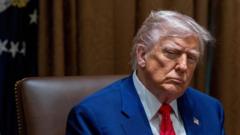After an eventful week marked by changes to his tariff strategy, President Donald Trump finds his ambitious trade goals in a state of flux. Just last week, he unveiled a sweeping tariff plan that aimed to dramatically alter global trading norms and disrupt established relationships with allies. However, in an unexpected pivot, Trump announced a delay on heightened tariffs for 90 days, primarily directing his focus towards a potential trade conflict with China.
This temporary halt raises questions about whether Trump is closer to attaining his trade aspirations. Here’s a look at five major objectives and their current status:
1) **Improved Trade Agreements**
Trump has long claimed that the U.S. has been taken advantage of in trade deals, and his initial tariff plan aimed to rectify this imbalance. The proposed flat 10% tariff on numerous nations—including many allied countries—sent shockwaves through global markets. The Trump administration has since reported over 75 world leaders reaching out for negotiations, suggesting that a potential resolution may be within reach. However, with a ticking 90-day deadline looming, the urgency for agreement intensifies.
2) **Revitalizing American Manufacturing**
For years, Trump has touted tariffs as a vehicle to bolster the U.S. manufacturing sector. While some domestic production may see a temporary uptick, industry leaders are likely to hesitate on making long-term investments until a stable tariff framework is in place. The recent fluctuations in Trump’s tariff orders create an environment of uncertainty, complicating any immediate plans businesses may have to expand operations.
3) **Confronting China**
Trump’s stance towards China has become increasingly pointed, labeling it the “real villain” in American trade woes. Despite significant pushback from China and the risks of economic escalation, the administration appears to be committed to addressing trade imbalances, even as discussions hint at possibly seeking a diplomatic route. Nonetheless, the tension is fraught—alienating potential allies while provoking a heavyweight adversary poses considerable risks.
4) **Increasing National Revenue**
Trump initially promised that his tariff strategy would generate significant revenue, potentially alleviating national debt. However, while estimates suggest that a universal 10% tariff could yield up to $2 trillion over ten years, this revenue hinges on sustained tariff levels and could shift as domestic production ramps up and tariff revenues decrease.
5) **Impact on Consumer Prices**
Finally, while Trump has expressed that tariffs will lead to lower prices for consumers by fostering competition, many economists disagree. The consensus indicates that tariffs may lead to increased costs for American families, with earlier studies projecting a financial burden of up to $1,253 per household each year. This trend could critically undermine public support and impact the political landscape for Trump and the Republican Party.
In summary, while Trump's tariff strategy has initiated a series of significant negotiations, the broader implications on trade, American industries, and consumer prices remain to be seen, with potential impacts rippling through the economy and electoral politics.




















